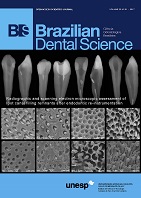Alternative therapies for denture stomatitis treatment: in vivo experimental model in rats
DOI:
https://doi.org/10.14295/bds.2017.v20i1.1368Resumo
Background: Denture stomatitis (DS) is a multifactorial condition that commonly affects denture users and is mainly caused by Candida albicans. Due to the toxic effects of antifungal therapy, new therapies for DS are claimed. Objective: The aim of the study was to evaluate the efficacy of aqueous extract of Buchenavia tomentosa and sodium bicarbonate against C. albicans in a model of DS in rats. Material and Methods: An acrylic resin device simulating a denture base was fixed covering the palate of forty-eight male rats followed by candidiasis induction. Rats were divided into 4 groups (n=12): Control, sodium bicarbonate, B. tomentosa and nystatin (positive control). Each group was subdivided according to the period of treatment; 24 hours (n=6) and 48 hours (n=6). Animals were sacrificed and had their devices removed for C. albicans counts and SEM analysis. The palate mucosa was removed and processed for histopathologic analysis. Results: After 24 hours of treatment, both B. tomentosa and nystatin groups reduced significantly C. albicans counts when compared to control (nystatin x control, p<0.01; B. tomentosa x control, p=0.03). The results were confirmed by the histologic analysis. Conclusion: Both the aqueous extract of B. tomentosa and sodium bicarbonate was able to significantly decrease C. albicans counts in an experimental model of DS.
Downloads
Downloads
Publicado
Como Citar
Edição
Seção
Licença
TRANSFERÊNCIA DE DIREITOS AUTORAIS E DECLARAÇÃO DE RESPONSABILIDADE
Toda a propriedade de direitos autorais do artigo "____________________________________________________________________" é transferido do autor(es) para a CIÊNCIA ODONTOLÓGICA BRASILEIRA, no caso do trabalho ser publicado. O artigo não foi publicado em outro lugar e não foi submetido simultaneamente para publicação em outra revista.
Vimos por meio deste, atestar que trabalho é original e não apresenta dados manipulados, fraude ou plágio. Fizemos contribuição científica significativa para o estudo e estamos cientes dos dados apresentados e de acordo com a versão final do artigo. Assumimos total responsabilidade pelos aspectos éticos do estudo.
Este texto deve ser impresso e assinado por todos os autores. A versão digitalizada deverá ser apresentada como arquivo suplementar durante o processo de submissão.




























